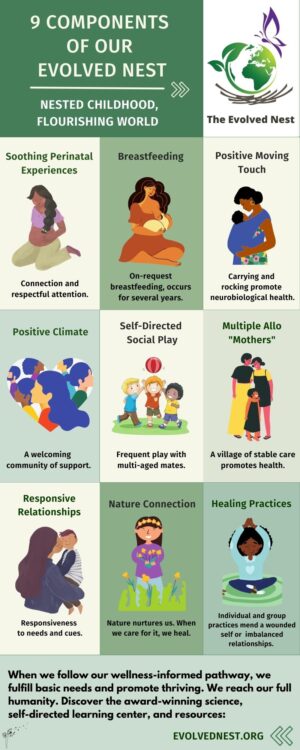Rock-a-bye Baby Documentary: The Harlow Monkey Experiment
James Prescott, PhD, Shares Insights Into the Classic Documentary
Read the original post by James Prescott, PhD, on his website, The Origins of Peace and Violence
About the Documentary
The Time Life documentary “Rock A Bye Baby” describes the influence of different practices in infant treatment and child rearing on emotional development, both in humans and in monkeys.
In the beginning, it is noted that the contact of the child to the mother represents the first socio-emotional interaction the child experiences and lays the fundamentals for its later behaviors. We learn that social animals isolated from their mothers and receiving no nurturing physical affection develop severe depression and can die from such deprivation. In addition, maternal-infant isolation that leads to sensory deprivation can cause developmental brain damage. These facts show that mother love has a neurobiological basis that is essential for life.
 Next we are introduced to Harry Harlow’s experiments with surrogate mothers which have shown that monkeys raised alone in an environment without mother and peers prefer to be with a cloth-covered mother surrogate without a milk bottle rather than with a wire-cage surrogate mother that provides a milk bottle, even when hungry.
Next we are introduced to Harry Harlow’s experiments with surrogate mothers which have shown that monkeys raised alone in an environment without mother and peers prefer to be with a cloth-covered mother surrogate without a milk bottle rather than with a wire-cage surrogate mother that provides a milk bottle, even when hungry.
They even cling to their cloth-covered wooden dolls when they are frightened and they experience the same emotional stress other social animals experience when isolated from their surrogate mothers. These experiments show that the need for a loving relationship (percepted, in this case, by the “fur”) is stronger than the mere need for food even when hungry. Thus, love-hunger is stronger than food-hunger.
Harlow’s experiments are part of most psychology textbooks of today.
The single greatest contribution to understanding the mother-infant separation syndrome was provided by Drs. William Mason and Gershon Berkson in their swinging mother surrogate experiments where the importance of body movement (vestibular-cerebellar simulation) in mother-infant bonding was documented. Monkeys raised singly in cages in a colony room with stationary cloth mother surrogates were compared to those raised with swinging cloth mother surrogates. The infant monkeys reared on the stationary mother surrogate developed all of the abnormalities which isolation-reared monkeys develop – depression, social withdrawal, aversion to touch, stereotypical rocking and chronic toe and penis sucking, self-mutilation and pathological violence as juveniles and adults.

The infant monkeys reared on the swinging surrogate mother developed normally with only minor stimulus-seeking behaviors, e.g. thumb-sucking. Depression, social withdrawal and avoidance of touch were absent in the swinging mother surrogate reared infant monkeys.
There are good reasons why infants and child seek to be carried on the body of their mothers and fathers and love to be rocked to sleep.
James W. Prescott’s experiments are less widely recognized. While the breakthrough studies by Drs. Mason and Berkson interpreted the importance of infant body movement in a social context, developmental neuropsychologist Dr. Prescott examined the neurobiological mechanisms involved 1.
Dr. Prescott then launched a series of brain-behavioral studies with various colleagues on the effects of loss of mother love on the structural and functional development of the brain. These studies documented both structural abnormalities of brain cells and functional abnormalities 2.
Studies by Dr. Selma Fraiberg on congenitally blind children demonstrated that when these blind children received sufficient body contact and movement stimulation from their parents they develop normal emotional-social behaviors. These effects are dramatically portrayed in “Rock A Bye Baby”, as are the studies of Dr. Mary Neal who constructed a swinging bassinet for premature babies. The premature babies that were given this artificial body movement stimulation showed accelerated neuromaturation, as reflected in head movements, crawling, grasping and other reflexes. These infants gained weight faster, had less health problems and were discharged earlier from the hospital than non-moved prematures.
In spite of the evident positive effects of auto-moving incubators on the health of premature babies as shown by Dr. Neal, such incubators are not in use in American hospitals. The necessity of movement is mostly overlooked in modern infant care and the newborns are placed on still mattresses.
“Rock A Bye Baby” also documents how a retarded institutionalized infant of six months of age can have that retardation reversed when provided a loving substitute mother in an intense “one-to-one” relationship. The longer the deprivation and the later a loving mother substitute is provided for such infants, the less recovery from the damage is possible.
The research of Dr. Rosenblum finally shows that there are different rearing styles in different monkeys. While the bonnet monkeys have the habit of changing mother figures without jealousy and adopting motherless children, the pigtail monkey mothers do not share their infants with others and the mother-infant bonding is extremely strong and possessive. The bonnet infant monkeys, when separated from their mother show no distress, as they are immediately adopted by other mother monkeys. This is not the case for the infant pigtail monkeys where they are left alone by the other mother monkeys and they become agitated and depressed, as the separation from mother continues.
1 Particularly, Dr. Prescott researched the importance of the vestibular-cerebellar sensory system in understanding the brain structures and processes involved in the maternal-infant social deprivation syndrome. Dr. Prescott renamed this syndrome as the “Somato-Sensory Affectional Deprivation (S-SAD) Syndrome” to emphasize the sensory neuropsychological processes that mediate the pathological behaviors resulting from loss of mother love; and developed a complex theory of brain function involving the cerebellum as a master regulatory system to account for the variety of pathological emotional-social behaviors found in the mother deprived monkeys.
2 The term functional abnormalities refers to electrical and biochemical dysfunction.


